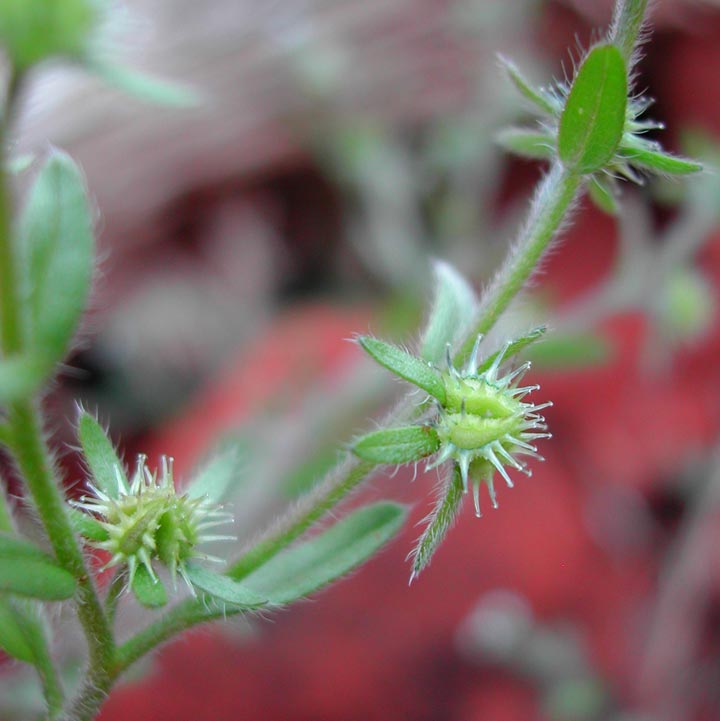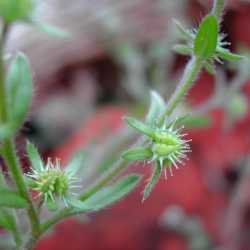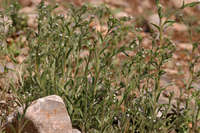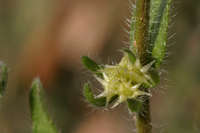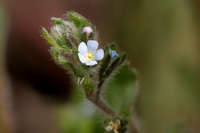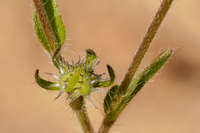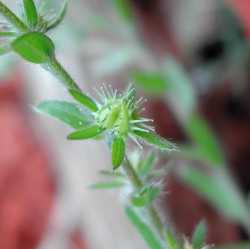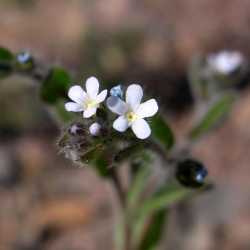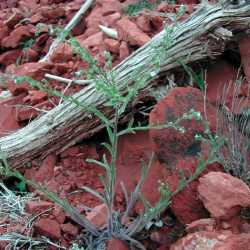Annual herb 15 - 60 cm tall
Stem: erect, rough with spreading hairs, and openly branched upward in the inflorescence.
Leaves: alternate, stalkless, non-toothed, soft-hairy, 2 - 5 cm long, under 1 cm wide, linear to narrowly lance-shaped or oblong, but without obvious lateral veins.
Inflorescence: terminating upper branches, somewhat elongate (up to 10 cm), hairy, and spike-like with several, alternate, small, blue flowers on short, ascending stalks subtended by narrow, 3 - 9 mm long bracts.
Flowers: many, alternate, short-stalked, blue, small, under 0.5 cm wide, radially symmetric, funnel-shaped or narrowly tubular with five spreading lobes.
Sepals: five, erect to ascending, about as long as petal tube, rough-hairy, narrow, somewhat lance-shaped with narrowed and pointed tips.
Petals: five, but fused for over half their length into a tube about equal to sepals, then separating into five, spreading, relatively short, rounded lobes. At the base of the spreading petal lobes, the throat of the petal tube is blocked by five small projections or appendages (fornices).
Stamens: five, attached to inside of petal tube, but not extending past the petal tube.
Pistil: with one, four-lobed, superior ovary; and one short style, which arises from between the four ovary lobes and never extends beyond the petal tube, but is often longer than the mature fruit.
Fruit: a prickly, 2 - 3 mm tall, egg-shaped (taller than wide) cluster of four, connected, spiny nutlets subtended by persistent, spreading to recurved sepals terminating 1 - 2 mm long, erect or ascending stalks. The nutlets are somewhat elongate triangular with two fairly flat inner sides, and a convex outer side, which at its two edges (adjacent to inner sides) are a single row of prominent, wide based, stiff, barbed or hooked prickles, and across the outer surface there are short, sharp bumps, but no prickles.
Similar species: Lappula redowskii var. occidentalis is very similar to L. squarrosa, except that species has two (or three) rows of barbed prickles bordering the edges of each nutlet, and the nutlet cluster is more rounded or about as tall as wide. Hackelia virginiana is also quite similar, but that species has obvious lateral veins on the leaves, many of the flowers (especially those further along the inflorescence branches) do not have subtending bracts, the fruit stalks curve downward, and the outer surface of each nutlet has many long prickles equal to those along the edges. Species of Lappula are also somewhat similar to Cynoglossum virginianum var. boreale, however, that taxon has some clasping leaves, and the nutlets are easily distinguished as four almost independent egg-shaped sections instead of an egg-shaped cluster.
Flowering: May to June
Habitat and ecology: Introduced from farther west, very rare in waste places.
Occurence in the Chicago region: non-native
Notes: Similar to the common name for Hackelia the species in the genus Lappula are also called stickseeds. This fits both genera well since their fruit have stiff barbed prickles, which allow the fruit to stick well to clothing and fur.
Etymology: Lappula derives from the diminutive of the Latin word lappa, meaning bur, in reference to the bur-like fruit. Redowskii is named after Ivan Redowsky, a Russian botanist (1774 - 1807). Occidentalis derives from the Latin word occident, which refers to the sunset, widely the west, and thus this variety is "of the west".
Author: The Field Museum
Much like no. 2 [Lappula squarrosa (Retz.) Dumort.]; stem often more spreading hairy and lvs often more softly hairy; nutlets 2-3 mm, the ovate dorsal area surrounded by a single row of prickles. Native of Eurasia and w. N. Amer., intr. as a weed in waste places and along railways e. to Mich., Io., and Mo., and occasionally farther e. Most of our plants, with the marginal prickles distinct to the base, are var. redowskii. (L. occidentalis) Var. cupulata (A. Gray) M. E. Jones, mainly of sw. U.S., also occasionally reaches the w. part of our range. It has the marginal prickles of the nutlets fused to form a cupulate (sometimes much swollen) border. (L. texana)
Gleason, Henry A. & Cronquist, Arthur J. 1991. Manual of vascular plants of northeastern United States and adjacent Canada. lxxv + 910 pp.
©The New York Botanical Garden. All rights reserved. Used by permission.


